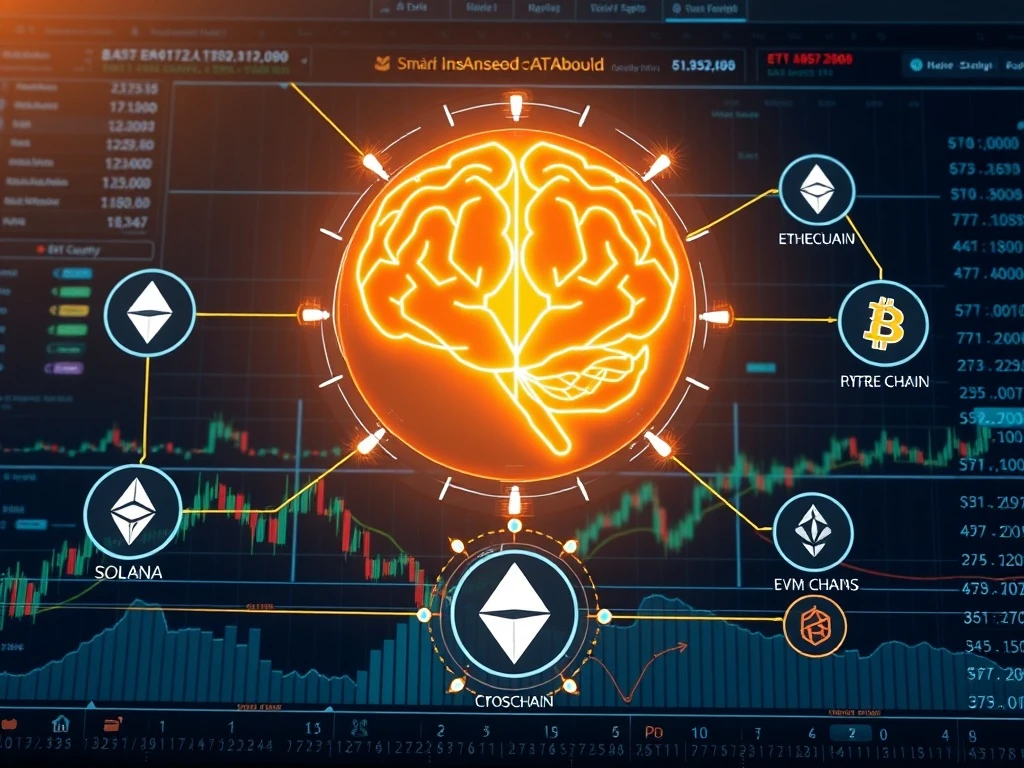Zircuit’s Revolutionary AI Trading Engine Unleashes Cross-Chain Power, ZRC Soars 50%

The decentralized finance (DeFi) landscape is constantly evolving, and innovation is key to staying ahead. Zircuit, a prominent player known for securing over $950 million in assets through its Deposit Vaults, has just made a groundbreaking announcement that could redefine automated trading. They’ve unveiled their new AI-driven Hyperliquid Engine, a powerful tool designed to enable real-time, cross-chain execution across both EVM and Solana ecosystems. This isn’t just another platform; it’s a strategic move to streamline automated trading, enhance security, and tap into new market efficiencies, especially as the ZRC token sees a significant surge.
What is Zircuit’s Hyperliquid Engine and How Does It Work?
At its core, Zircuit’s Hyperliquid Engine is an advanced AI-driven trading solution built to address some of the most pressing challenges in decentralized finance. Imagine a system that can execute trades across different blockchain networks, like Ethereum Virtual Machine (EVM) chains and Solana, in real-time. That’s precisely what this engine promises.
The platform, launched by the firm behind Deposit Vaults, aims to streamline automated trading through advanced signal detection and robust security protocols. Key features of the Hyperliquid Engine include:
- AI-Driven Market Analysis: Uses artificial intelligence to detect trading signals and identify opportunities across various markets.
- Cross-Chain Auto-Routing: Automatically finds the most efficient paths for trades across disparate blockchain ecosystems, reducing liquidity fragmentation.
- Sequencer Level Security (SLS): A critical feature designed to protect against common DeFi attacks, ensuring institutional-grade security for your trades.
Dr. Martin Derka, co-founder of Zircuit, highlighted that this tool aims to combine unparalleled speed with robust protection, enhancing the overall on-chain finance experience. It’s a testament to Zircuit’s commitment to secure and efficient DeFi.
How Does AI Trading Benefit DeFi Users?
The demand for automated tools in DeFi has skyrocketed as market complexity increases. Zircuit’s Hyperliquid engine leverages cutting-edge AI trading capabilities to meet this need. This isn’t just about faster trades; it’s about smarter trades.
AI can analyze vast amounts of market data far quicker than any human, identifying subtle trends, arbitrage opportunities, and optimal entry/exit points. For traders, this means potentially higher efficiency and the ability to capitalize on fleeting market discrepancies that would otherwise be missed. The engine’s design focuses on enabling complex strategies to be executed seamlessly, offering a significant advantage in volatile crypto markets. This focus on speed and automation addresses critical challenges in DeFi, such as arbitrage opportunities and liquidity fragmentation.
Why is Cross-Chain Execution a Game-Changer?
One of the biggest hurdles in DeFi today is liquidity fragmentation across different blockchain ecosystems. Traders often have to navigate multiple wallets, bridges, and platforms to execute strategies across chains. Zircuit’s Hyperliquid engine directly addresses this by offering true cross-chain execution.
This capability allows users to execute trades and strategies seamlessly between EVM-compatible chains (like Ethereum, Polygon, BSC) and the high-throughput Solana network. This dramatically reduces friction, saves time, and potentially opens up new arbitrage and yield opportunities that span multiple blockchains. The vision is clear: a more unified and accessible decentralized market, simplifying the multi-chain environment for both institutional and retail traders.
What Triggered the ZRC Token Surge?
Following the announcement of the Hyperliquid Engine, Zircuit’s native token, ZRC, experienced a notable surge, climbing 50% in value. While Zircuit has not directly linked this price movement to the engine’s performance, market reactions often reflect investor confidence in new product launches and technological advancements.
Analysts suggest that the enthusiasm stems from the engine’s potential to significantly impact the DeFi space by enhancing cross-chain trading efficiency and security. A robust new product, especially one leveraging AI and addressing critical market needs, can naturally boost investor sentiment. This ZRC surge underscores the market’s anticipation for tools that can genuinely improve the decentralized trading experience.
What’s Next for Zircuit’s Hyperliquid Engine?
Zircuit has outlined a clear roadmap for the Hyperliquid Engine’s rollout, ensuring a structured and community-driven expansion. The phased approach includes:
- Late July 2025: A closed beta for existing Deposit Vault users, allowing for early feedback and refinement.
- August 2025: A public launch with SDK access for developers, fostering innovation and community-built solutions.
- Q4 2025: Ecosystem grants to incentivize the development of community-built AI models and strategies, expanding the engine’s utility.
To encourage early adoption, Zircuit is offering trading incentives, including fee rebates and competition bounties. The firm also plans to expand the engine’s capabilities to additional blockchains, though specific timelines for these expansions are yet to be announced. This forward-looking approach positions Zircuit to be a key innovator in the evolving DeFi landscape.
How Does Zircuit Ensure Security?
While the potential of the Hyperliquid Engine is immense, addressing security and scalability challenges remains paramount. Zircuit has made security a cornerstone of its design, leveraging battle-tested smart contracts and advanced anti-phishing technology.
The integration of Sequencer Level Security (SLS) is a proactive measure to mitigate common attack vectors in DeFi. This focus aims to allow the Hyperliquid Engine to compete with centralized high-frequency trading systems in terms of speed and efficiency, all while upholding the principles of decentralization and user control. It’s a delicate balance, but Zircuit’s emphasis on robust protection is a reassuring sign for users navigating decentralized markets.
Conclusion
Zircuit’s launch of the AI-driven Hyperliquid Engine marks a significant milestone in the DeFi space. By combining the power of artificial intelligence with seamless cross-chain execution and institutional-grade security, Zircuit is setting a new standard for automated trading. This innovation promises to reduce barriers for traders, enhance market efficiency, and bridge fragmented ecosystems. As the DeFi landscape continues its rapid evolution, Zircuit’s strategic integration of AI and multi-chain capabilities could indeed redefine how participants interact with decentralized markets, prioritizing both innovation and safety.
Frequently Asked Questions (FAQs)
What is Zircuit’s Hyperliquid Engine?
Zircuit’s Hyperliquid Engine is an AI-driven trading platform designed to enable real-time, cross-chain execution of trades across different blockchain ecosystems, including EVM-compatible chains and Solana. It aims to streamline automated trading with advanced signal detection and security protocols.
How does the Hyperliquid Engine enable cross-chain trading?
The engine utilizes ‘Cross-Chain Auto-Routing’ to automatically find the most efficient paths for executing trades across disparate blockchain networks. This allows users to seamlessly trade between different chains without manual bridging or complex multi-platform navigation.
What is Sequencer Level Security (SLS)?
Sequencer Level Security (SLS) is an institutional-grade security measure integrated into the Hyperliquid Engine. It is designed to mitigate attack risks and protect users’ assets by enhancing the security protocols at the transaction sequencing level, a critical component in decentralized finance.
Why did the ZRC token surge after the announcement?
Following the announcement of the Hyperliquid Engine, Zircuit’s native token, ZRC, surged 50%. This market reaction is typically driven by investor confidence and anticipation for new products and technological advancements that are perceived to significantly impact the DeFi space and enhance the utility of the underlying token.
When will the Hyperliquid Engine be fully available?
The Hyperliquid Engine is rolling out in phases. A closed beta for existing vault users is set for late July 2025, followed by a public launch with SDK access for developers in August 2025. Ecosystem grants to incentivize community-built models are planned for Q4 2025.
What are the benefits for traders using this engine?
Traders can benefit from AI-driven market analysis for smarter trades, real-time cross-chain execution to capitalize on opportunities across different networks, institutional-grade security, and potential trading incentives like fee rebates and competition bounties, all aimed at improving efficiency and reducing friction in DeFi trading.









